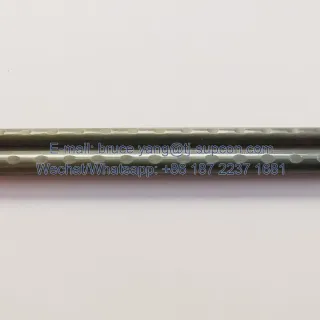Understand high-strength and high-efficiency prestressed steel wire in one article
1 Concept of prestressed steel wire
Abbreviation of steel wire for reinforcement of prestressed concrete structure
2 Classification of pc wire
(1) According to surface shape:
Smooth round (smooth surface) and regularly deformed (notched, female thread, male thread, ribbed).
(2) According to processing method:
Cold drawn, straightened and tempered, stabilized, cold rolled, quenched and tempered (oil, water, quenched).
(3) According to tensile strength:
Low-strength low-carbon cold drawn wire has a tensile strength below 800MPa;
Medium-strength prestressed steel wire has a tensile strength of 800~1470MPa:
High-strength prestressed steel wire has a tensile strength of 1470~1860MPa;
Ultra-high-strength prestressed steel wire has a tensile strength of more than 1860MPa.
(4) According to the cross-sectional shape:
round, elliptical, semicircular, twisted ear, spline shaft type, etc.
(5) According to the relaxation level:
ordinary relaxation level (level I relaxation); low relaxation level (level II relaxation).
(6) According to whether the surface is coated (coated):
smooth surface without coating, galvanized, galvanized aluminum rare earth coating, epoxy coating, other coating (coating).
(7) According to chemical composition:
carbon steel wire and low (micro) alloy steel wire.
Additional reading:Introducing the Next Generation in Structural Stability: TMT Steel Bars
Understanding JIC & JIS Hydraulic Fittings
Customized Steel Square Tube
3 Characteristics of prestressed steel wire
The carbon content of Prestressed Concrete Steel Wire is generally between 0.6% and 0.90%. It should comply with relevant national standards. The wire rod diameter is φ6.5~14.0mm, and the wire rod metallographic structure is mainly troostite structure, and there should be no martensite, network cementite and structure that is harmful to performance.
Material characteristics
High-efficiency structural prestressed concrete steel wire requires excellent clean steel wire to be manufactured.
Prestressed concrete requires prestressed steel wire to have comprehensive mechanical properties such as sufficient tensile strength, excellent toughness, high fatigue strength, and low stress relaxation. When prestressed steel wires such as PC steel wire, PC steel strand, and PC steel rod made of prestressed steel special wire are used in concrete products, it can not only save steel, but also significantly improve the performance of concrete in the use stage, delay the appearance of cracks, reduce the crack expansion width under high load levels, reduce or even eliminate the deflection under the use load, and improve the shear bearing capacity and fatigue strength of concrete products.

Raw material quality control
Dimension control - Control the rolling temperature to make the rolling temperature of the same batch consistent, and minimize the fluctuation of the rolled product size caused by temperature changes affecting deformation resistance and width. Implementing micro-tension rolling will minimize the influence of rolling tension, the most important factor causing the dimensional accuracy of the rolled product. Optimize the roller pass design and enhance the error elimination function of the pass system during the rolling process. Use Morgan's sixth-generation finishing mill, equipped with an ORBIS optical diameter gauge, to detect indicators such as wire diameter deviation and ovality online.
Surface quality - implement billet grinding, control billet quality, remove various defects on the billet surface, prevent surface defects such as scarring, pits, folds, cracks, inclusions, etc. caused by the introduction of wire rods; avoid folding during wire rolling due to deep grooves formed by improper billet processing. Remove the head and tail of the billet thoroughly to avoid shrinkage, looseness, stratification, inclusions, etc. from being introduced into the wire.
Chemical composition - improve the purity of molten steel through long-process converter or high-proportion hot-charged electric furnace steelmaking process. Import high-quality iron ore and select high-purity raw and auxiliary materials to reduce the entry of impurity elements into the molten steel. Use LF furnace or VD method or RH method for secondary refining to accurately adjust the chemical composition of molten steel.
Cleanliness - strictly control the ladle refining, tundish metallurgy, and continuous casting processes to fully remove non-metallic inclusions and achieve high cleanliness of steel, which is conducive to improving the processing performance and comprehensive mechanical properties of cold heading steel wire.
Segregation - The end electromagnetic stirring and advanced dynamic modular light pressure technology are used during continuous casting to minimize the center segregation of the steel billet and avoid the formation of banded structure and center segregation in the wire.
Uniformity - In order to make the steel highly uniform, various technologies such as extremely low superheat casting, crystallizer electromagnetic stirring, end electromagnetic stirring, dynamic light pressure, constant drawing speed casting, and homogenization heating are used in the steel manufacturing process.
Metallographic structure - Controlled rolling and controlled cooling are implemented on the Morgan sixth-generation rolling mill to enable the wire to obtain a metallographic structure that is conducive to drawing or cold heading.
Inspection and delivery
The inspection items of the wire include chemical composition, mechanical properties, surface quality, dimensional deviation, segregation, decarburization, grain size, and cleanliness.
4 Application of prestressed steel wire
Prestressed steel wire is mainly used in industrial plants, multi-level high-end buildings, prestressed stand buildings and various foundations, building column modification and reinforcement, prestressed steel structures, various bridges on railways and highways, urban overpasses, containment of nuclear power plants, TV towers, water towers, concrete silos, sewage treatment pools, geotechnical anchoring projects, water conservancy and hydropower projects, prestressed concrete standard components, etc. Its application areas are still expanding.

